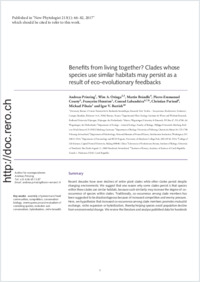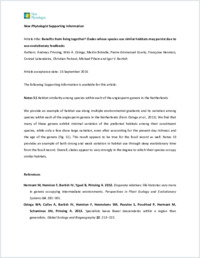Benefits from living together? Clades whose species use similar habitats may persist as a result of eco-evolutionary feedbacks
- Prinzing, Andreas University Rennes 1/CNRS Unit ‘Ecobio – Ecosystèmes, Biodiversité, Evolution’, Rennes, France
- Ozinga, Wim A. Experimental Plant Ecology, Institute for Water and Wetland Research, Radboud University Nijmegen, the Netherlands - Alterra, Wageningen University & Research, AA Wageningen, the Netherlands
- Brändle, Martin Department of Ecology – Animal Ecology, Faculty of Biology, Philipps-Universität Marburg, Germany
- Courty, Pierre-Emmanuel Department of Biology, University of Fribourg, Switzerland
- Hennion, Françoise University Rennes 1/CNRS Unit ‘Ecobio – Ecosystèmes, Biodiversité, Evolution’, Rennes, France
- Labandeira, Conrad Department of Paleobiology, National Museum of Natural History, Smithsonian Institution, Washington, DC, USA - Department of Entomology and BEES Program, University of Maryland, College Park, MD, USA - College of Life Sciences, Capital Normal University, Beijing, China
- Parisod, Christian Laboratory of Evolutionary Botany, Institute of Biology, University of Neuchatel, Switzerland
- Pihain, Mickael University Rennes 1/CNRS Unit ‘Ecobio – Ecosystèmes, Biodiversité, Evolution’, Rennes, France
- Bartish, Igor V. Institute of Botany, Academy of Sciences of Czech Republic, Pruhonice, Czech Republic
-
2017
Published in:
- New Phytologist. - 2017, vol. 213, no. 1, p. 66–82
Assembly of present and fossil communities
Competition
Conservation biology
Enemy pressure and mutualism of coexisting species
Evolution and conservatism
Hybridization
Niche breadth
English
Recent decades have seen declines of entire plant clades while other clades persist despite changing environments. We suggest that one reason why some clades persist is that species within these clades use similar habitats, because such similarity may increase the degree of co-occurrence of species within clades. Traditionally, co- occurrence among clade members has been suggested to be disadvantageous because of increased competition and enemy pressure. Here, we hypothesize that increased co-occurrence among clade members promotes mutualist exchange, niche expansion or hybridization, thereby helping species avoid population decline from environmental change. We review the literature and analyse published data for hundreds of plant clades (genera) within a well-studied region and find major differences in the degree to which species within clades occupy similar habitats. We tentatively show that, in clades for which species occupy similar habitats, species tend to exhibit increased co-occurrence, mutualism, niche expansion, and hybridization – and rarely decline. Consistently, throughout the geological past, clades whose species occupied similar habitats often persisted through long time-spans. Overall, for many plant species, the occupation of similar habitats among fellow clade members apparently reduced their vulnerability to environmental change. Future research should identify when and how this previously unrecognized eco-evolutionary feedback operates.
- Faculty
- Faculté des sciences et de médecine
- Department
- Département de Biologie
- Language
-
- English
- Classification
- Biological sciences
- License
- License undefined
- Identifiers
-
- RERO DOC 279072
- DOI 10.1111/nph.14341
- Persistent URL
- https://folia.unifr.ch/unifr/documents/305237
Other files
Statistics
Document views: 96
File downloads:
- cou_blt.pdf: 149
- cou_blt_sm.pdf: 171

